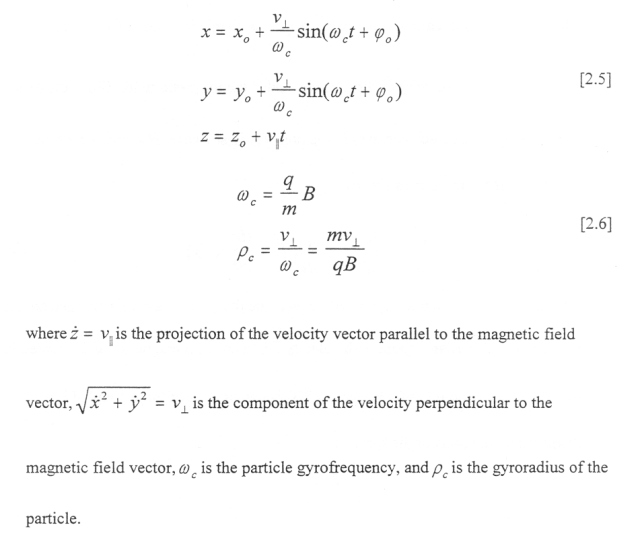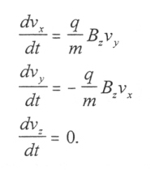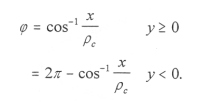Investigation of the Magnetosphere of Ganymede with Galileo's Energetic Particle Detector
Ph.D. dissertation by Shawn M. Stone, University of Kansas,
1999.
Copyright 1999 by Shawn M. Stone. Used with permission.
2.1 Maxwell's Equations and the Lorentz Force
The motion of charged particles in electromagnetic fields is governed by Maxwell’s equations and the Lorentz force. Maxwell’s equations in differential form are given by


where ρ (charge density) and J (current density) are the source terms. The non- relativistic Lorentz force equation in mks form is given by
|
|
[2.2] |
where P is the momentum of the particle, q is its charge in Coulombs, E is the electric field, v is velocity of the particle, and B the magnetic field. Since the mass of the charge is assumed constant in the non-relativistic case, P=mv, the time derivative of the momentum gives
|
|
[2.3] |
To illustrate the basic motion we will investigate the simple case of a charged particle moving in a Cartesian system with velocity v in a uniform magnetic field oriented in the z direction where E=0. Equation [2.3] becomes a set of three coupled linear differential equations of the form
|
|
[2.4] |
This set of three equations is solved in many texts on fundamental electromagnetic and space physics [Parks, 1981; Griffiths, 1989]. In closed form, with the initial conditions x=x0 and v=v0,
the solutions to equation [2.4] are

Figure 2.1 shows solution [2.5] in schematic form. The particle gyrates about the magnetic field line with gyrofrequency ωc as it translates in the z direction. The trajectory for this particle is therefore helical in shape. The angle of the velocity vector relative to the magnetic field vector is defined as the pitch angle
|
|
[2.7] |
Figure 2.1 Schematic of the solution to Equation 2.4. The particle trajectory is that of a helix. The orientation of the velocity vector V can be broken up into components parallel and perpendicular to the magnetic field vector. The angle between the velocity vector and the magnetic field vector is the pitch angle α. The angle between the x axis and the projection of the velocity vector onto the xy plane is the phase angle Φ.

The phase angle is arbitrarily defined. For this situation, the phase angle is measured relative to the x axis (Φo=0) so
|
|
[2.8] |
For practical cases, such as this thesis, the phase angle is defined in a magnetic coordinate system discussed in Section 3.4.3.

By taking the time derivative where dm0/dt=0 and dv/dt=0 yields the equation
|
|
[2.10] |
which is discussed in detail by Clemmow and Dougherty [1969].
In more complicated, spatially inhomogeneous magnetic fields such as those occurring in planetary magnetospheres, the closed form solution to Equation [2.3] or [2.10] is not possible. The configuration of the magnetic field and presence of electric fields make it algebraically intractable. To solve Equation [2.3] or [2.10] numerical methods that approximate a solution must be employed. One such approach is the guiding center approximation.
In this study numerical methods will be used to integrate Equation [2.10] to determine the trajectories of the charged particles in the vicinity of Ganymede. The framework of the guiding center is useful in the case of the long range motions of electrons at Ganymede. It is then useful to review the basics to provide support for later analysis.
Next: 2.2 The Guiding Center Equation of Motion
Return to dissertation table of contents page.
Return to main
Galileo Table of Contents Page.
Return to Fundamental
Technologies Home Page.
Updated 8/23/19, Cameron Crane
QUICK FACTS
Mission Duration: Galileo was planned to have a mission duration of around 8 years, but was kept in operation for 13 years, 11 months, and 3 days, until it was destroyed in a controlled impact with Jupiter on September 21, 2003.
Destination: Galileo's destination was Jupiter and its moons, which it orbitted for 7 years, 9 months, and 13 days.









